From disordered eating to eating disorders
EATING DISORDERS IN U.S. COLLEGE CAMPUSES

Living in the U.S. as an international student
I have been living in the U.S. for 5 years. I came here as an exchange student for my junior year of high school. A lovely family from Geneseo, New York welcomed me into their home when I was 16. I made really good friends, and my time in Geneseo was so satisfactory that I knew I couldn’t go back and finish high school in my small hometown in Spain. I went home for the summer and graduated high school with another host family in Rochester, MN. During my senior year I struggled with a binge eating disorder. I am fully recovered now and looking back at it I can’t help but realize all the factors that had an influence on me, all the advertisements promoting weight loss, all the diet culture over social media, all the “quick fixes” promoted by influencers, all the comments my friends would make. Even now, at college, when I go out I hear comments such as “I feel so skinny today, I only ate X” or “I didn’t eat dinner because I wanted to go out”. I understand that this might just be my friends here, but when I compare it to my friends in Spain we do not make comments like that. How does modern diet culture lead to disordered eating in young adults in the U.S.? In order to answer this question I have investigated the prevalence of eating disorders in the U.S. along with the normalization of disordered eating in college, and the messages spread amongst social media.
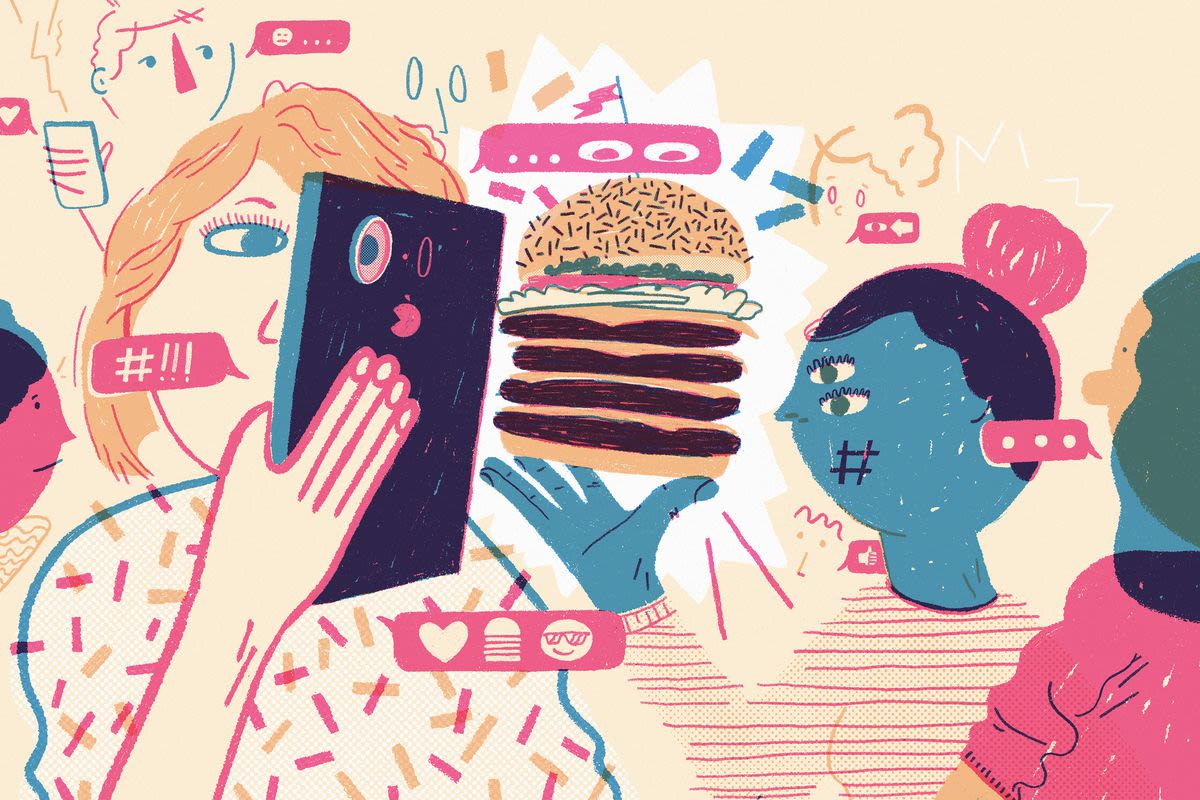
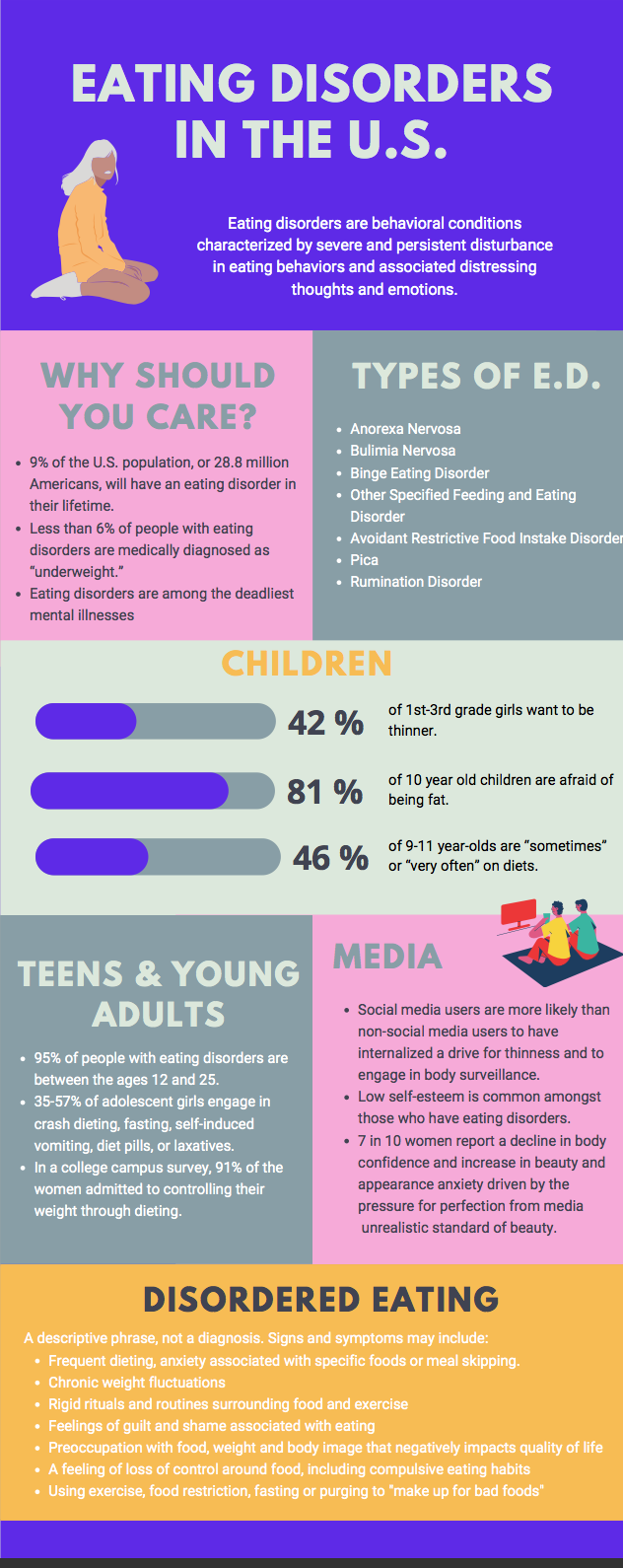
Why should you care?
In the United States, 28.8 million people, or 9% of the population will have an eating disorder in their lifetime (ANAD, 2021). This makes eating disorders a common condition. The American Psychiatric Association (2021) defines eating disorders as “behavioral conditions characterized by severe and persistent disturbance in eating behaviors and associated distressing thoughts and emotions'', making eating disorders a mental health issue. The DSM-5 (2013) classifies 7 types of eating disorders: Anorexia Nervosa, Bulimia Nervosa, Binge Eating Disorder, Other Specified Feeding and Eating Disorder, Avoidant Restrictive Food Intake Disorder, Pica, and Rumination Disorder. Although some types are more prevalent than others, it is important to acknowledge that eating disorders do not look the same on everyone. In fact, less than 6% of people diagnosed with an eating disorder have an underweight BMI (ANAD, 2021). Contrary to the term eating disorder, disordered eating is not a diagnosis, but as a descriptive phase usually used when the symptoms experienced by someone do not exactly fit any of the DSM-5 conditions. In other words, someone might show signs of disordered eating such as food and weight obsession, but they might not have an eating disorder in DSM-5 standards.
Eating disorders have been widely studied. Research points to a significant relationship between media use and disordered eating, such that individuals who use media the most are at an increased risk of developing an eating disorder (Sidani et al., 2016). Another study found a link between social media use and comparisons which eventually led to lower self-esteem (Midgley et al., 2020). This is extremely dangerous in children and teenagers. According to the National Association of Anorexia Nervosa and Associated Disorders (2021); 42% of 1st-3rd grade girls want to be thinner, 81% of 10 year old children are afraid of being fat, 46% of 9-11 year-olds are “sometimes” or “very often” on diets. To put it another way, even children and pre teens are at vulnerable risk.

How do ads portray the relationship Americans have with food?
In a 2019 study by Sacred Heart University, all the food advertisements analyzed (100) showed food addiction characteristics. These food addiction behaviors entail everything from using food as emotional comfort and as a means to replace relationships, to being unable to control cravings. Additionally, 95% of the ads portrayed a “deep emotional attachment to food” (Danowski, 2019). The examples are infinite but for the purpose of my project I am analyzing the Pepperidge Farm Milano 2019 TV Commercial 'Save Something for Yourself'.
In this short advertisement we can observe a woman wrapped in a towel relaxing in what seems to be a spa. As soon as the camera zooms out, we realize she is actually laying on her bathroom floor. As the camera zooms out even more, we realize that the bathroom is full of kids’ toys. Her kid knocks on the door and she pretends to be the father. At the end, we hear a voiceover saying “You gave them your bathtub, don’t give them your cookies. Save something for yourself”. In other words, the commercial illustrates food as an emotional escape. The woman is thoroughly enjoying her “guilty-pleasure” by herself. The DSM-5 states “eating alone because of feeling embarrassed by how much one is eating” as a binge-eating disorder symptom (American Psychiatric Association, 2013). Although the advertisement is fairly short we do not know if this is what the mother is doing or not, and some viewers could understand it as so.
In a Lay’s advertisement from 2020, a woman is struggling to decide what kind of Lays chips she wants to eat. The bags of chips appear to be talking to her, until another woman interrupts her with “I thought we talked about talking to the chips” to which she replies “I can't help it”. Although this might seem normal, this lack of self-control and obsession over food might eventually lead to disordered eating. Normalizing this behavior is the opposite of rising awareness to the eating disorder crisis.
It is understandable that the previous statements might seem an exaggeration to some readers, but hundreds of commercials like this are made every year normalizing disordered eating so we have become desensitized to them. Why can’t food just be food? Why does a mother need to lay on her bathroom floor just to eat all the cookies by herself? Why does the media need to depict unhealthy eating behaviors? All these messages are viewed by preteens, teenagers and young adults who are going to grow up thinking these behaviors are normal. Some of these teenagers will be diagnosed with an eating disorder in the future.
What are the messages spread in social media?
The U.S. has one of the greatest rates of social media users in the world. In fact, more than 70% of the population holds a social media account (. With such extensive use, one can’t help but wonder what message social media spreads on disordered eating. After extensive research, I was able to notice three clear different points of view across all social media platforms. On one hand we have the body positivity movement, which focuses on body acceptance. Related to it, but slightly different, we have a fitness movement that also promotes mental health awareness. Lastly, opposite to the body positivity movement we have a diet culture approach to health.

In the first lines of this next post, Landry refers to the first week of the year, when many people set weight loss goals for the upcoming year. She looks back at her old self, and feels proud of her progress. She doesn’t need “external validation” from society anymore, all that matters now is that she is healthy and understands that bodies do not need to look a certain way. Landry accepts herself in every form and she encourages other women to do the same; to ditch the scale, to quit dieting, to acknowledge disordered eating, to be healthy.
1. The body positivity movement
The body positivity movement challenges society’s beauty standards. Its main goals include the acceptance of all body types and the promotion of self-confidence. Body positivity encourages people to break away from societal expectations and diet culture. An example of a body positivity account on Instagram is @thebirdspapaya. With 1.9M followers, Sarah Landry inspires other women to accept their body as it is and to acknowledge that going up a size is okay. Landry considers herself a body confidence activist, and she spreads her message through her Instagram captions, her blog, and her podcast, The Papaya Podcast.
Landry recognizes the power that society has on us when she admits that going up a size is not easy, it’s a “mind trick”. But despite what beauty standards might tell us, we are “still good” because our bodies do not define our values. Our bodies are simply our bodies.
2. A mental and physical health approach
The next message I’ve noticed promotes physical health just as much as it promotes mental health. It promotes body acceptance at the same time it inspires us to be the best and strongest version of ourselves. With over 3. Million followers on Instagram, and 2.04 million subscribers on Youtube, Whitney Simmons embodies this movement. Like Sarah Landry, Whitney Simmons’ past featured an obsession with being thin and sexy due to unrealistic body standards. With time, Whitney’s platform has changed and her message is not how to have the perfect body anymore, but rather how to enjoy food and live a healthy lifestyle. In a Youtube video titled “FOLLOWING MY OLD UNHEALTHY FULL DAY OF EATING” published in November 2019, Simmons walks us through her old diet and fitness goals. She says “ My only fitness goal at this time was to be as skinny and as tiny and thin as possible. It was a very unhealthy mindset. My fitness goals have shifted so much over the last few years”. Simmons acknowledges how unhealthy and draining her old lifestyle was at the same time she is raising awareness on disordered eating. Additionally, she brings to the public her fear for carbohydrates, a major macronutrient, and her obsession with protein. These types of dietary restrictions are common disordered eating behaviors. As she explains her old habits and how she got over them, she encourages other women to do the same by treating food for what it is; fuel.
Posts like these promote a balanced lifestyle, a life where you enjoy your food and drinks with friends and a social life, but you also exercise and eat a variety of nutritious foods. Mental health is just as important as physical health. This view on health and wellness is centered around an 80/20 approach, meaning that 80% of the time you are eating right and exercising while the other 20% you can eat less nutritious foods, like pizza or french fries. What’s important here is that we listen to our bodies and we give in to our cravings.
3. Diet culture
Lastly, the third message spread is that of diet culture. This is the side of social media where detox teas and fad diets are promoted. Mental health is not mentioned, and the main goal of the movement is to lose weight at any cost. A simple search on YouTube with the words “weight loss tea before and after'' yields hundreds of results. In a particular video with over 745 thousand views, the YouTuber Saucy Suzyy is giving her audience the recipe for a weight loss juice that will help you “lose [...] 30 pounds in 14 days by drinking this twice a day”. The video is not backed by science and actually spreads false information to viewers. People who do this and do not get the desired results might develop an obsession over weight loss which could eventually lead to disordered eating. In fact, there is an association between societal pressure to fit “thin” beauty standards and the development of eating disorders (Wilson, 2002). This has been found to be true across all ethnic groups.
Another popular drink is a detox tea called “ballerina tea”. Videos encouraging its use are sponsored by the company itself. Detox teas and weight loss supplements are not FDA approved. One particular case study involving tea included a 60 year old woman suffering from acute liver failure. The patient had been drinking herbal detox tea 3 times a day for 14 days prior. Researchers emphasized their concern over the safety of weight loss products such as detox teas and their possible hepatotoxicity (Kesavarapu et al., 2016). Thus, it is our responsibility to raise awareness on the physical and psychological dangers of diet culture as it pressures individuals to be thin at all costs.
Diet culture is also vouched by some celebrities who are known to have lost weight, or who follow under the ideal beauty standards. In 2018, Kim Kardashian, posted a picture promoting the use of an “appetite killer lollipop” by the brand Flat Tummy Co. Kardashian received a lot of criticism for this, especially from body confidence activists.
What do students think?
Disordered eating is something that I have been noticing more since I moved to the U.S., especially during my years at college. I wanted to know what my American peers thought of it. Were they as aware of it as me? Or was I the only one due to my cultural background? Or was I aware because of my personal experience? I wanted to dig deeper and understand the role this plays in American culture versus other countries. Thus, I conducted the same cultural survey twice. The one written in English was given to my American peers, and the other one with the exact same questions but translated to Spanish was given to my Spanish peers. Unfortunately, I only obtained 17 responses from Spain compared to 44 responses from the U.S.
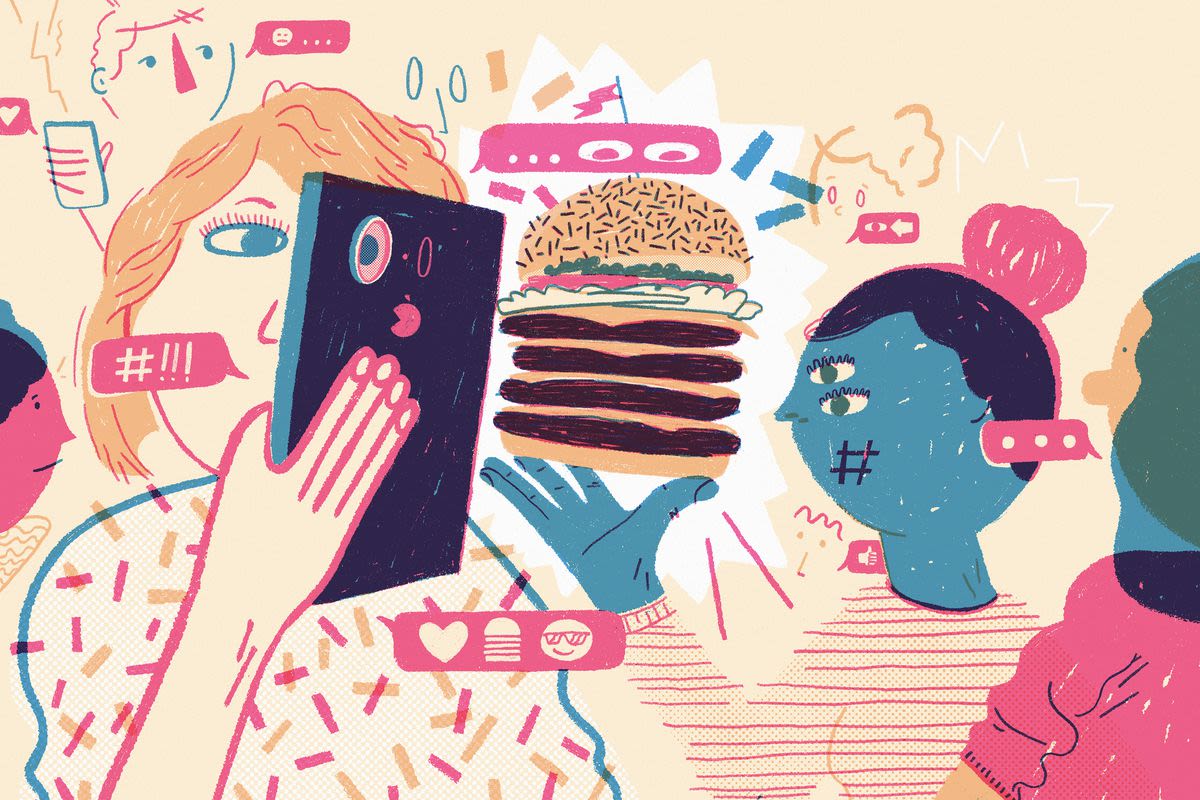
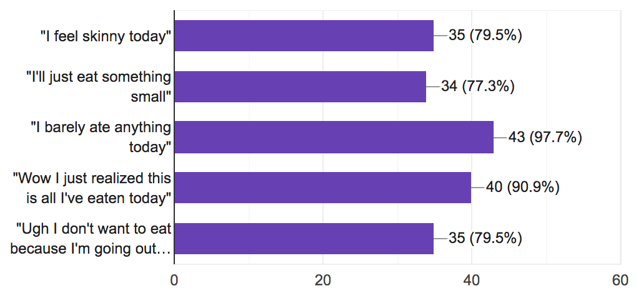
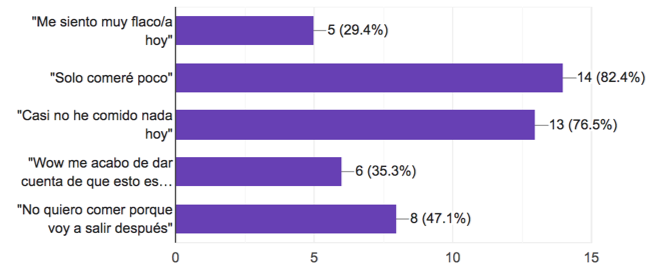
Food and body appearance related comments were significantly more common in the participants from the United States. For instance 80% of the responders in the U.S. claimed to have heard or said “I feel skinny” in comparison to only 29% of Spanish participants. Additionally, the frequency these comments were made or heard in Spain is significantly lower than in America, as shown in the figures. According to the participants, in the U.S. these comments were mostly made/heard on a weekly basis. 27% of the participants claimed to hear or make body appearance and food related comments on a daily basis. In contrast, the majority of the Spanish students stated that these comments were heard/made on a monthly basis. No participant claimed to hear body appearance and food comments on a daily basis.
Next, participants were asked to describe what they felt and did when they heard their friends say comments like the ones in the figures. Examples of responses are as follows:
“I feel bad if I ate more than my friend did, or then I start thinking about my body and get uncomfortable”, “Insecure”, “It makes me feel a similar way to them and motivates me to also participate in the behavior”, “Anxious as I’m overweight”, “Some of them bother me (the ones about not eating a lot in the day) but other ones are okay”, “I think these comments affect me on a subconscious level, as after hearing them I am less inclined to eat certain foods deemed as "unhealthy," by societal standards, and find myself eating less as well”, “Horrible”, “Sometimes can be very triggering and leads me to not want to eat”.
There were three types of responses shown in both countries. A group of students said they don’t notice these comments because of how often they are made. They claimed to be indifferent towards them. Another group of students said they have feelings of concern for their friends so they encourage them to eat more. Lastly, some participants felt pressured to eat less. One thing is clear: students are significantly affected by food and body related comments from their peers.

Participants were also asked about the frequency they limit their food intake in preparation of social events. In Spain, a total of 65% responded with “never” or “occasionally/ on a yearly basis” in comparison to 43% in America. Furthermore, 25% of my American peers confirmed they limited their food intake “often/ on a weekly basis”, while only 6% of my Spanish peers do it with the same frequency.
Something that struck out to me was the responses I received from the following question “Have you ever felt pressured to limit your food intake because of the environment you were in? (i.e. people were not eating, or someone made a comment and it influenced you)”. 57% of people in the U.S. said yes, in comparison to 82% of people in Spain. I was expecting these two percentages to be similar. Answers could’ve been affected by the smaller number of participants in the Spanish group, and the difference in the gender of participants, with the U.S. group having more male participants. It seems like although Spanish people hear/say body appearance and food comments less often, they are more affected by it, which could be the reason why one personally doesn’t make them. Moreover, one could say that since American students are more exposed to the comments they are desensitized to them and do not even notice them.
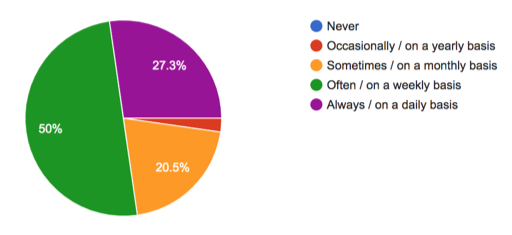
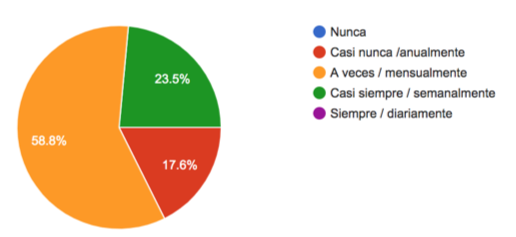
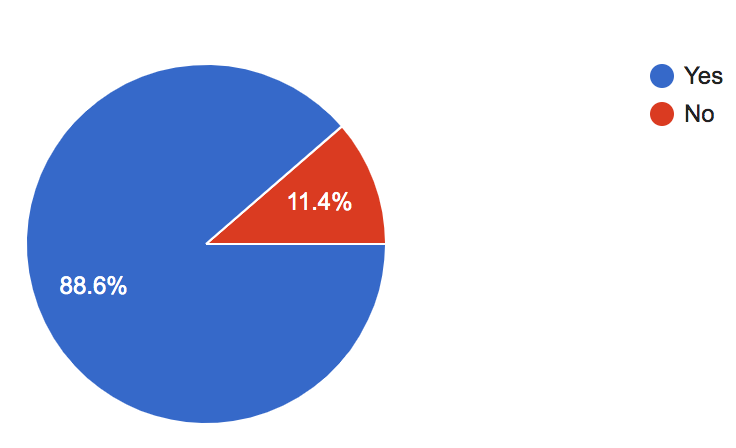
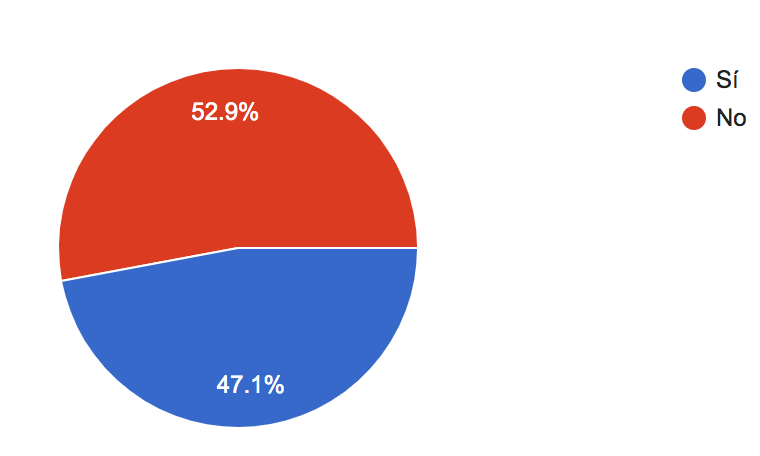
Lastly, participants were asked whether or not they thought eating disorders are normalized in college. In the U.S. 89% of students said yes. On the other hand, 47% of Spanish students said yes. Although the survey doesn’t account for the differences in the number of participants or their gender, if we take into account all the previous responses, I think we can conclude that eating disorders and disordered eating are more normalized in American colleges, than in Spanish universities.
What does Binghamton University do and how does it influence disordered eating?
What are Binghamton’s University policies on nutrition and body image? BU has a very accessible page with resources. The following resources are available: Decker Student Health Services Center, Dietitian, Eating Awareness Committee, Fit University, Health and Wellness
Studies, Internship in Health and Wellness, Mindful, Nutritional Services, University Counseling Center, VINES (Volunteers Improving Neighborhood Environments, Inc), and Weight Watchers at Work.
Decker Student Health Services Center is the primary care facility for BU students. Through the link offered in the Dietitian section, you can make an appointment with a registered dietitian free of charge. The Eating Awareness Committee is part of the Counseling services by BU. They consist of professional staff, faculty and students across campus. According to their website, their goal is to minister education and resources to both campus and the community pertaining to body image, eating disorders, and health and wellness. Out of the first three resources presented this is the first one that mentioned body image and eating disorders. Furthermore, they claim to continually evaluate the need of eating disorder prevention and treatment for students. This is extremely important and as a Binghamton University student myself I am happy Binghamton recognizes the issue and is willing to do something about. That being said, their website does not give any information on how to contact them or when/where they meet.
Next, we have Fit University, a student association-chartered club which advocates for healthy living via tabling, and presentations. But again, no information is given on how to join the club. Moreover, the department of Health and Wellness Studies offers a diversity of courses in health, nutrition, and activities. It is noted that “professional staff in the department can refer students to appropriate services both on and off campus”. In other words, if a student were to show symptoms of disordered eating, a professional would direct them to the correct organization or facility.
Mindful is a program by Sodexo, the company that runs Binghamton University’s Dining Services. They offer healthy nutritious meals on campus and if you go to their website you can subscribe to their biweekly newsletters that will help you make healthier choices. I believe Mindful is a valuable program that has brought many balanced meals to students. The University Counseling Center offers preventive and clinical services, but there is no mention of eating disorders or body image issues.
On another side, VINES (Volunteers Improving Neighborhood Environments, Inc) is a community organization that focuses on having a sustainable and fair community food system. It promotes diversity and unity. Their goals are to install public gardens, urban agriculture and green space for the neighborhood.
Lastly, we have Weight Watchers at Work. This is an on-campus support group for people who want to lose weight. Again, not much information is listed. In fact, all I can get from them is that their meeting lasts for 45 minutes and that there’s a private weigh-in followed by a 30 minutes meeting. It’s not expressed whether this support group is led by professionals, and whether or not they make sure the students are aware of disordered eating behavior.
In short, it seems like Binghamton University promotes healthy living and balanced eating. However, not many resources mention body image issues nor disordered eating. Furthermore, many of the resources that are posted are not easily accessible and it doesn’t look like they are active resources. Lastly, unlike the topics of alcohol abuse and sexual assault Binghamton University does not offer presentations on disordered eating during orientation. That being said, it seems like this is a pretty standard practice for a public 4 year college.

What is the best course of treatment for college students?
According to John Hopkins All Children’s Hospital (2021), 95% of people diagnosed with eating disorders are between the ages of 12 and 25. In other words, research confirms that young people are at increased risk of developing an eating disorder. College students find themselves in a challenging environment defined by the clashing of school work and peer pressure with low self-esteem, anxieties, and learning difficulties. The pressure students are under contributes to the latent mental health conditions. Dr. Alison Baker terms this a “perfect storm” for eating disorders (Jacobson, 2020). For instance, a girl who was able not only to manage stress but also academically succeed in high school, might struggle with mental health issues in college due to lack of support and increased workload pressure. In fact, fully developed eating disorders usually start around the ages of 18 and 21 (Hudson et al., 2007). Therefore, the best preventative measures are those that target this population.
What, then, is the best course of treatment for college students? StudentBodies-Eating Disorder is a 10 week online intervention whose aim is to decrease eating disorder symptoms as well as weight and body concerns. Participants in the program are required to attend 10 weekly sessions with a coach in which they use self-monitoring logs and journal entries. Additionally, there’s an anonymous discussion board to encourage participants to help one another. Lastly, 2 months after the program is completed, patients receive a booster session to assist them in staying on track with their progress .In a randomized controlled trial, Saekow and colleagues (2015) found that SB-ED showed potential efficacy to treat eating disorders in a non-clinical setting. The results indicated that the intervention program showed a large effect on minimization of “related psychopathology, weight concerns, and psychosocial impairment” (Saekow et al., 2015). This type of digital cognitive behavior therapy (CBT) program emphasized the importance of having readily available mental health services on campus. When it comes to mental health issues, physicians tend to say that when a patient seeks help half the work is already done (Shatkin, 2020). Therefore, college campuses must prioritize the accessibility of mental health disorders. As research shows, a good way to do this is to implement digital CBT programs to college campuses.

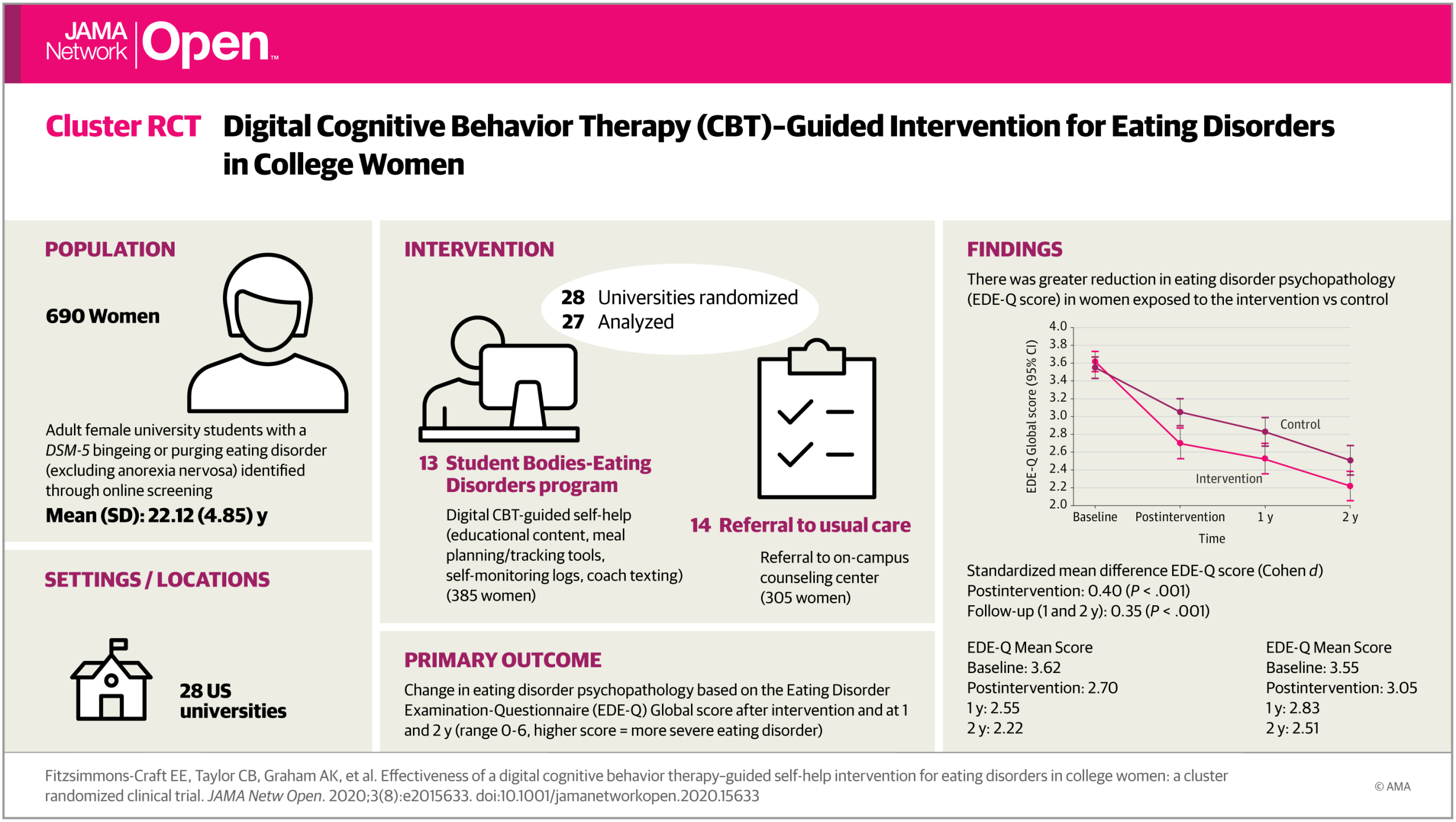
So, how how does modern diet culture lead to disordered eating in young adults in the U.S.?
I have shown how prevalent eating disorders in the U.S. are, especially among teenagers and young adults. Furthermore, I have demonstrated that U.S. food advertisements portray eating disorder behaviors such as loss of control over food, eating alone, and using food as a way to cope with emotions. I believe the normalization of this behaviors in advertisements influences our eating behaviors as a society. Next, the diet culture side of social media encourages us to fit into the unrealistic standards. The dangerous message is to be thin at all costs. While these thoughts might not trigger certain patterns of behavior for some people, other individuals might fall into a disordered eating pattern (e.g. skipping meals, obsessing over food, calorie counting). Coupled with low self esteem these behaviors might evolve into an eating disorder. Additionally, in the survey I conducted with both Spanish and U.S. students, more American participants agreed that eating disorders are normalized in college. Although Binghamton University has a website with a list of resources for those struggling with disordered eating, this is not enough. This moves me to consider the implementation of StudentBodies-Eating Disorder online intervention program to Binghamton’s campus. Furthermore, I believe awareness needs to be raised in the community via mandatory educational presentations for incoming freshmen.

References
- American Psychiatric Association. (2013). Diagnostic and statistical manual of mental disorders (5th ed.). https://doi.org/10.1176/appi.books.9780890425596
- Danowski, D. (2019). Bet you can't eat just one: Binge eating disorder promotion in American food advertising. Media Literacy and Academic Research, 2(1), 6-23
- Eating Disorder Statistics: General & Diversity Stats: ANAD. National Association of Anorexia Nervosa and Associated Disorders. (2021, March 3).
- Hudson, J. I., Hiripi, E., Pope, H. G., & Kessler, R. C. (2007). The Prevalence and Correlates of Eating Disorders in the National Comorbidity Survey Replication. Biological Psychiatry, 61(3), 348–358. https://doi.org/10.1016/j.biopsych.2006.03.040
- Jacobson, R. (2020, August 21). Eating Disorders in College Students. Child Mind Institute. https://childmind.org/article/eating-disorders-and-college/.
- Kesavarapu, K., Kang, M., Shin, J., & Rothstein, K. (2016). Herbal Detox Tea: A Potential Cause of Acute Liver Failure. American Journal of Gastroenterology, 111. https://doi.org/10.14309/00000434-201610001-01904
- Midgley, C., Thai, S., Lockwood, P., Kovacheff, C., & Page-Gould, E. (2020). When Every Day is a High School Reunion: Social Media Comparisons and Self-Esteem. https://doi.org/10.31234/osf.io/zmy29
- Nutrition and Body Image - B-Healthy: Binghamton University. B. (2021). https://www.binghamton.edu/bhealthy/wellness-resources/nutrition.html.
- Reesse, J., Stromberg, S., Denhardt, B., Diaz, R., & Campbell, S. (2021). Eating Disorder Facts. Johns Hopkins All Children's Hospital.
- Saekow, J., Jones, M., Gibbs, E., Jacobi, C., Fitzsimmons-Craft, E. E., Wilfley, D., & Barr Taylor, C. (2015). StudentBodies-eating disorders: A randomized controlled trial of a coached online intervention for subclinical eating disorders. Internet Interventions, 2(4), 419–428. https://doi.org/10.1016/j.invent.2015.10.004
- Shatkin, J. P. (2020). Increasing Access for the Treatment of Eating Disorders Among College Students. JAMA Network Open, 3(8). https://doi.org/10.1001/jamanetworkopen.2020.16117
- Sidani, J. E., Shensa, A., Hoffman, B., Hanmer, J., & Primack, B. A. (2016). The Association between Social Media Use and Eating Concerns among US Young Adults. Journal of the Academy of Nutrition and Dietetics, 116(9), 1465–1472. https://doi.org/10.1016/j.jand.2016.03.021
- Statistics & Research on Eating Disorders. National Eating Disorders Association. (2020, May 8). https://www.nationaleatingdisorders.org/statistics-research-eating-disorders.
- Tankovska, H. (2021, February 25). Topic: Social media usage in the United States. Statista. https://www.statista.com/topics/3196/social-media-usage-in-the-united-states/#:~:text=With%20over%2070%20percent%20of,increase%20to%20approximately%20257%20million.
- Wilson, G. T. (2002). The controversy over dieting. In C. G. Fairburn &K. D. Brownell (Eds.), Eating disorders and obesity: A comprehensive handbook, (2nd ed., pp. 93–97). London: Guilford Press.
Mediography
- 2020 joy says WHAT :60 [Video file]. (2020, October 19). Retrieved May 13, 2021, from https://youtu.be/mZ0bQgwSUrE
- Conceptual - Bug With A Pen. (n.d.). [Digital image]. Retrieved May 13, 2021, from http://bugwithapen.com/conceptual
- Francesca. (2021, April 21). Instragram post [Digital image]. Retrieved May 13, 2021, from https://www.instagram.com/p/CN6_QFcJGpr/
- Georgia. (2021, April 21). Instragram post [Digital image]. Retrieved May 13, 2021, from https://www.instagram.com/p/CN-ePFkD-wD/
- Gold, M. (2015, December 22). Binghamton University Healthy Eating [Digital image]. Retrieved May 13, 2021, from https://www.binghamton.edu/blog/index.php/blog/story/13029/8-reasons-binghamton-university-is-ranked-in-the-the-top-25-healthiest-coll/
- H, V. (2017, November 2). How is Instagram affecting mental health [Digital image]. Retrieved May 13, 2021, from https://medium.com/@ranbowhorse/how-is-instagram-affecting-mental-health-concerns-7246bfafe012
- JAMA Network Open. (2020, August 21). Digital Self-Help Therapy for Eating Disorders in College Women [Digital image]. Retrieved May 13, 2021, from https://media.jamanetwork.com/news-item/digital-self-help-therapy-for-eating-disorders-in-college-women/
- Kardashian, K. (2018, May 16) Instragram post [Digital image]. Retrieved May 13, 2021, from https://www.instagram.com/p/Bi0NTablmo4/
- Landry, S. (2020, December 30). Instragram post [Digital image]. Retrieved May 13, 2021, from https://www.instagram.com/p/CJbIzrClIqo/
- Landry, S. (2021, April 1). Instragram post [Digital image]. Retrieved May 13, 2021, from https://www.instagram.com/p/CNIRfssFjGO/
- Laru, S. (Director). (2020, August 23). 3 ballerina tea before AND After| Detox TEA (must SEE) [Video file]. Retrieved May 13, 2021, from https://www.youtube.com/watch?v=2SzqE5raqww
- Save Something For Yourself - Pepperidge Farm Milano [Advertisement]. (2019). Retrieved May 13, 2021, from https://www.ispot.tv/ad/waDH/pepperidge-farm-milano-save-something-for-yourself
- Simmons, W. (Director). (2019, November 18). Following my old unhealthy full day of eating [Video file]. Retrieved May 13, 2021, from https://www.youtube.com/watch?v=36nVW6D3dSE
- Suzzy, S. (Director). (2020, December 01). How i lost weight fast | super fast easy pineapple weight loss drink | quick results flat stomach [Video file]. Retrieved May 13, 2021, from https://www.youtube.com/watch?v=R_wlvtNuQKw
